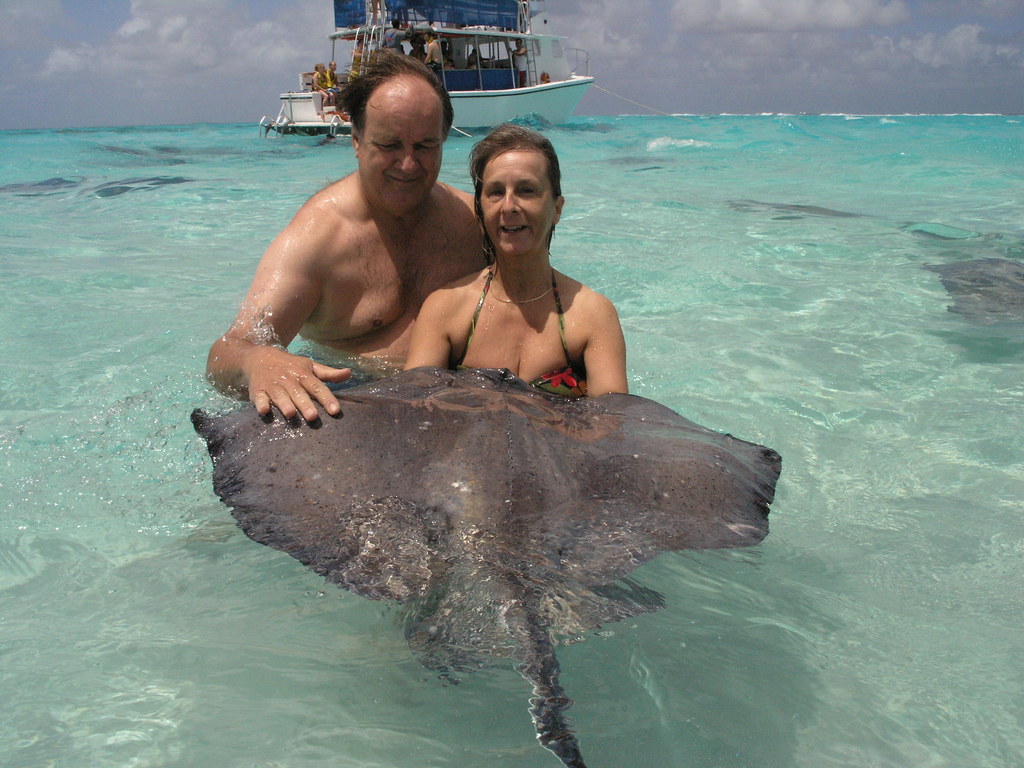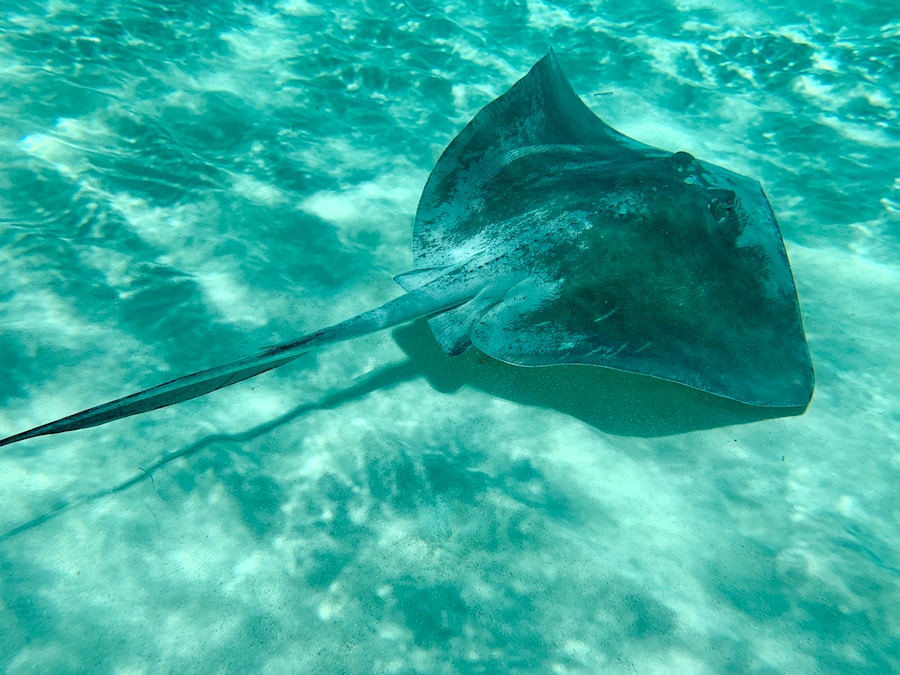Stingray Safety: Debunking Myths About Swimming with Stingrays
Table of Contents
Swimming with stingrays can be an exciting and unique opportunity for adventure seekers. However, it’s important to understand the risks and safety measures involved before taking the plunge. Stingrays are a type of cartilaginous fish that typically live in shallow, warm waters. They have a flattened body shape and a long, whip-like tail that sometimes contains one or more venomous spines.
At SeaWorld, guests have the opportunity to enter a controlled environment and swim with these fascinating creatures. But, there are certain myths surrounding stingrays that need to be debunked before you embark on this adventure.
One common misconception is that all stingrays are dangerous and aggressive. In reality, stingrays are generally docile animals that only use their venomous spines for self-defense when they feel threatened or cornered. Another myth is that stingrays will attack humans on sight. This is also untrue as stingrays often actively avoid human contact.
Understanding the behavior of stingrays is key to enjoying a safe and memorable experience. In this blog post, we’ll explore the safety measures put in place by Aquatica and SeaWorld, as well as provide tips on how to safely interact with these fascinating creatures.
Common misconceptions about swimming with stingrays
Swimming with stingrays can be a thrilling and awe-inspiring experience, but unfortunately, there are many myths and misconceptions surrounding these majestic creatures that can make some people hesitant to take the plunge.
One of the most common misconceptions is that stingrays are aggressive and will attack humans without provocation. However, this couldn’t be further from the truth. Stingrays are actually quite docile and will only attack if they feel threatened or provoked. In fact, stingrays are more afraid of us than we are of them!
Another common myth is that stingrays are venomous and that their stings are always deadly. While it is true that stingrays do have venomous spines on their tails, these spines are only used in self-defense. Stingray stings are painful, but they are rarely fatal as long as they are treated promptly and properly.
It’s also important to note that stingrays are not naturally aggressive toward humans. It is only when they feel threatened or cornered that they may lash out with their stinger. By following proper safety guidelines and respecting these creatures, it is possible to have a safe and enjoyable experience swimming with stingrays at Aquatica and SeaWorld.
Stingray safety guidelines at Aquatica and SeaWorld
Swimming with stingrays can be a thrilling and unforgettable experience. However, it’s important to keep safety in mind when interacting with these fascinating creatures. At Aquatica and SeaWorld, there are strict stingray safety guidelines in place to ensure that both guests and stingrays remain safe.
- guests are required to wear wetsuits and rubber-soled shoes when interacting with stingrays. This is to protect guests from accidental stings and to prevent the transmission of any germs or bacteria from the guests to the stingrays.
- guests are not allowed to touch or feed the stingrays with their hands. Instead, they can use a special feeding tool provided by the staff. This is to prevent any accidental stings or injury to the stingrays that can occur if they mistake a hand for food.
- guests are required to follow the staff’s instructions at all times. The staff is trained to watch over the guests and the stingrays to ensure that everyone is safe and having a good time.
- guests are instructed to be gentle and respectful when interacting with the stingrays. These are living creatures that deserve our care and consideration.
What to expect during a stingray encounter
If you’re planning to swim with stingrays at Aquatica or SeaWorld, it’s important to know what to expect during your encounter. First and foremost, keep in mind that these are wild animals, and they should be treated with respect. That being said, the stingrays at these parks are accustomed to human interaction and are generally quite friendly.
When you enter the stingray pool, you’ll notice that the water is relatively shallow and clear. The stingrays will be swimming around, and you may even see them gliding along the bottom of the pool. Your guide will give you some safety instructions and explain how to properly interact with the stingrays.
During your encounter, you’ll have the opportunity to touch and feed the stingrays. They have a soft, smooth texture and are quite docile. You may even feel them glide over your feet as they swim by. It’s important to remember to be gentle and not to grab or squeeze the stingrays.
If you’re feeling adventurous, you can even try to get a stingray to “give you a kiss.” This involves holding a small piece of fish between your lips and waiting for the stingray to swim over and take the fish with its mouth. It’s a fun and unique experience that many visitors enjoy.
Benefits of swimming with stingrays
Swimming with stingrays is an unforgettable experience that offers many benefits. Firstly, stingrays are gentle creatures that are not aggressive by nature. They are often curious and friendly towards humans, making them great companions to swim with. By swimming with stingrays, you can gain a new appreciation for these amazing sea creatures and develop a deeper understanding of their behavior and habitat.

Another benefit of swimming with stingrays is the opportunity to learn more about marine conservation efforts. At Aquatica and SeaWorld, guests can participate in educational programs that teach about the importance of protecting our oceans and the wildlife that inhabits them. By interacting with stingrays and other marine animals, visitors can gain a greater understanding of the impact that humans have on our planet and what we can do to help preserve it.
Swimming with stingrays is a great way to connect with nature and create unforgettable memories with family and friends. Stingrays are beautiful creatures and the opportunity to swim with them in a controlled environment is a unique experience that is not to be missed. At Aquatica and SeaWorld, guests can have the thrill of swimming with these amazing animals while feeling safe and protected at all times.
How to interact with stingrays safely
If you’re visiting Aquatica or SeaWorld and are excited to interact with the stingrays, it’s important to know how to do it safely. Stingrays are generally gentle creatures, but they can become agitated if they feel threatened or if they are startled. Here are some tips for interacting with stingrays safely:
- Always listen to the trainers and follow their instructions. They are experts on stingrays and will be able to guide you on how to interact with them properly.
- Approach the stingrays slowly and calmly. Do not splash or make sudden movements, as this can startle them.
- Do not touch the stingrays with your hands or feet. Instead, use one or two fingers to gently stroke their backs.
- Avoid touching the stingrays’ tails or barbs. These are their defense mechanisms and can be dangerous if they feel threatened.
- Do not pick up or hold the stingrays unless instructed to do so by a trainer.
- Do not chase the stingrays or try to ride them. This can cause them to become agitated and can lead to injuries.
- Always wash your hands thoroughly after interacting with the stingrays.
By following these tips, you can have a safe and enjoyable experience interacting with the stingrays at Aquatica and SeaWorld. Remember to always respect the stingrays and their environment, and to listen to the trainers for guidance on how to interact with them safely.
Stingray conservation efforts at Aquatica and SeaWorld
Aquatica and SeaWorld not only pride themselves on providing quality entertainment to their visitors but also on their commitment to animal conservation and welfare. They take their responsibility seriously and have implemented a range of conservation efforts to preserve the natural habitats of the animals they exhibit, including the stingrays.
One of the ways they achieve this is by participating in breeding programs that help to preserve endangered species of stingrays. These programs have been incredibly successful, and some of the rays bred in captivity have been released back into the wild. By doing this, they help to maintain healthy populations of the various species of stingrays in their natural habitats.
Aquatica and SeaWorld also work closely with marine biologists and researchers to study and understand the behavior of stingrays and other marine animals. This research is essential in developing better ways of conserving these animals and their natural habitats. By sharing their knowledge and findings with other organizations and institutions, Aquatica and SeaWorld play a significant role in shaping the future of marine conservation.
In addition to conservation efforts, Aquatica and SeaWorld also educate their visitors about stingrays, their habitats, and the importance of conservation efforts. They offer educational programs and exhibits that showcase the beauty and importance of these creatures. This helps to raise awareness and understanding of the vital role that stingrays play in the ecosystem and the need to protect them.
Importance of education and awareness
When it comes to swimming with stingrays, education and awareness are critical components in ensuring the safety of both the stingrays and the visitors. There are many myths and misconceptions surrounding stingrays that can lead to dangerous situations and misunderstandings.
First and foremost, it’s important to understand that stingrays are not naturally aggressive animals. In fact, they are usually quite docile and only sting as a defense mechanism when they feel threatened or provoked. By understanding the behavior of stingrays, visitors can avoid situations that may trigger a defensive response.
Furthermore, it’s important for visitors to be aware of the proper way to interact with stingrays. This includes avoiding sudden movements, not touching the stingray’s eyes or tail, and not feeding them any food that is not provided by the facility. Visitors should also be aware of the signs that a stingray may be feeling threatened, such as flapping its wings or arching its back.
Education and awareness also extend to the facility itself. Aquatica and SeaWorld have strict safety procedures in place, and visitors should be aware of these procedures before entering the water. Staff members are trained to recognize and respond to any potential issues, and visitors should feel comfortable asking questions and seeking assistance if needed.
What to do in case of a stingray sting
Despite taking all necessary precautions, sometimes accidents happen and you or someone you know may get stung by a stingray. In case of a stingray sting, it’s important to seek medical attention right away. While stingray stings are not typically life-threatening, they can cause intense pain and discomfort.
The first thing to do is to remove any visible spines or barbs from the wound. This can be done with a clean pair of tweezers or by using the edge of a credit card to gently scrape the area. It’s important not to squeeze the wound or try to remove any spines that are deeply embedded as this can cause further injury.
Next, rinse the affected area with warm water. This will help to relieve pain and reduce the risk of infection. You can also soak the wound in warm water for 30-90 minutes to help alleviate the pain.
Over-the-counter pain relievers such as ibuprofen or acetaminophen can also be taken to help manage the pain. In some cases, your doctor may prescribe stronger pain medication or antibiotics to prevent infection.
It’s important to monitor the wound closely over the next few days to ensure that it is healing properly. Signs of infection include redness, swelling, and pus. If you notice any of these symptoms, seek medical attention right away.
In conclusion, while stingray stings can be painful, they are manageable with prompt medical attention and proper first aid. By following all safety guidelines and taking necessary precautions, your chances of getting stung by a stingray are greatly reduced.
FAQ
Are stingray encounters safe?
A: Absolutely! Just remember to stroke them lightly with an open hand and keep your distance. Stingrays are no more dangerous than any other underwater creature – just don’t forget your manners!
Is it safe to swim in the ocean with stingrays?
A: It is generally safe, although swimming too close to a stingray may cause it to feel threatened. Always stay alert and give the stingray plenty of room to move around.
Can you touch stingrays at SeaWorld?
A: Of course! At SeaWorld, the expert trainers will make sure that your encounter with one of the friendly Resident Rays is both enjoyable and safe.
Why do stingrays at public aquariums lack stinging spines?
A: Our resident rays have had their spines clipped, which is a safe and humane process. This helps us ensure that your experience is safe, and makes sure that our stingrays remain healthy and happy!
Final Thoughts
We hope you found our article on Stingray Safety informative and helpful. Many people are afraid to swim with stingrays because of the myths surrounding them. However, when proper precautions are taken, swimming with stingrays can be a safe and enjoyable experience. We hope that we have debunked some of the most common myths surrounding these beautiful creatures and have given you the confidence to try it out for yourself. Remember, always follow the guidelines and instructions given by your guide or trainer, and enjoy the experience of swimming with these amazing creatures!

